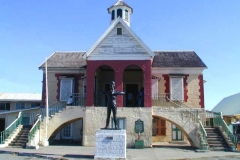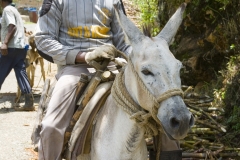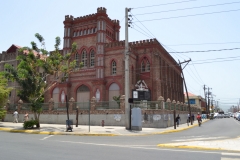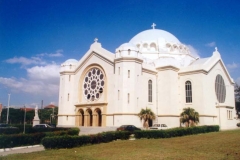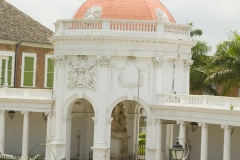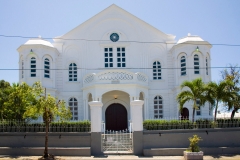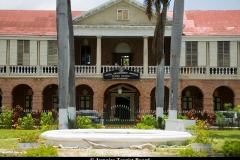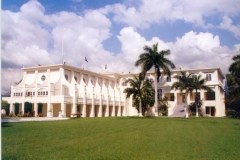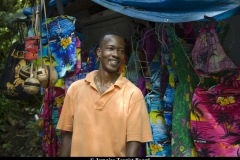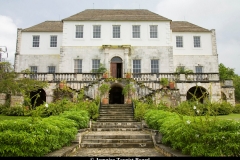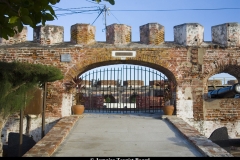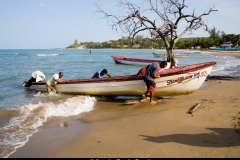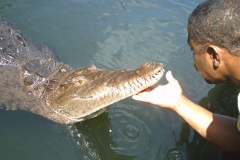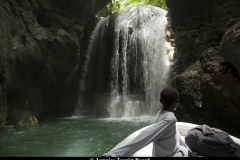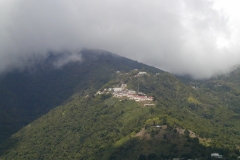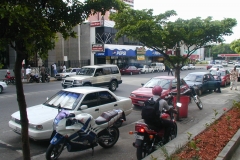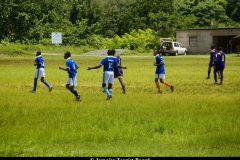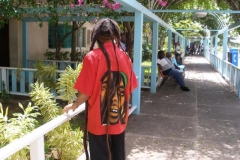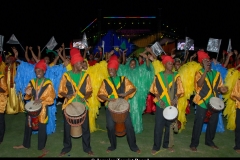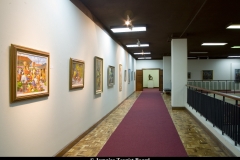JAMAICA
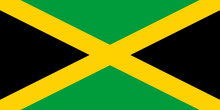 Jamaica is located in the Greater Antilles in the south of Cuba. It is the third largest island in the Caribbean ; its area is 10 990 sq km. The eastern region is very mountainous and rugged. The western region is a limestone plateau. The tropical climate is more humid in the north than in the south which is occupied by a forest vegetation. The Blue Mountains are erected in the north-east of the capital, Kingston. Blue Mountain Peak is Jamaica’s highest summit with its 2256m. But, there are other ranges in the island : in the east, John Crow Mountains ; in the south-west, Santa Cruz Mountains ; in the centre, Dry Harbour Mountains. In some places, the jungle reigns with snakes as the Jamaican boa and with swamps occupied by American crocodiles and manatees.
Jamaica is located in the Greater Antilles in the south of Cuba. It is the third largest island in the Caribbean ; its area is 10 990 sq km. The eastern region is very mountainous and rugged. The western region is a limestone plateau. The tropical climate is more humid in the north than in the south which is occupied by a forest vegetation. The Blue Mountains are erected in the north-east of the capital, Kingston. Blue Mountain Peak is Jamaica’s highest summit with its 2256m. But, there are other ranges in the island : in the east, John Crow Mountains ; in the south-west, Santa Cruz Mountains ; in the centre, Dry Harbour Mountains. In some places, the jungle reigns with snakes as the Jamaican boa and with swamps occupied by American crocodiles and manatees.
Jamaica has over 3000 varieties of flowering plants ; the palm trees (including the 30m-high royal palm) and the fruit trees are numerous.
The island owns more than 250 species of bird (egrets, stilts, crows, vultures, owles, doves, woodpeckers etc). About 700 species of fish (like barracudas, bonitos, rays, sharks, redsnaper…) and many marine turtles live in the coral reefs located along the shore.
Agriculture is an important activity. The country exports bananas, yams, coffee, sugar and rum. Jamaica is the world’s 5th bauxite producer. Tourism is an important economic sector.
Christopher Columbus landed on Jamaica on May 5, 1494. At that time, about 100 000 Arawak Indians lived in the island. They came from the American continent and settled there around AD 700. These Amerindians called this island “Xamayca” (Land of Wood and Water). When Columbus returned to Spain, he encouraged the Spaniards to go to live in this island. The few Spaniards who accepted to settle in Jamaica founded three towns : Sevilla, near to St Ann’s Bay ; Minella, in St James ; Santiago de la Vega, called today Spanish Town. Some of these settlers became, for example, cattle rearers or animal skins sellers.
Sixteen years later, the Spanish colonists arrived in Jamaica with sugar cane and also slavery. So, the peaceful Arawaks worked for the Spaniards as slaves and showed them the island because they looked for gold.
By the end of the 16th century, the Amerindians had been exterminated by the hard labour, European diseases etc. Because of the lack of gold, Jamaica lost interest for Spain and the Spanish settlers. In 1655, led by Sir William Penn and the general Robert Venables, the English appropriated this large Caribbean island. Among the first colonists sent by England, many were former prisoners (like in other colonies). The authorities promised them freedom and a patch of land after working for five years without being paid. Other settlers were English and Portuguese Jews merchants. From 1672, the English colonists transported to Jamaica thousands of African, in particular from Nigeria, Benin and Ghana ; there were, in the 1700s, 300 000 slaves in Jamaica. These slaves grew sugar cane. Sugar fetched a high price in Great Britain. The English made so much money so Jamaica was nicknamed “The Jewel in England’s Crown”…
Several revolts of slaves happened : “Nanny’s revolt”, in the 18th century, a cheftaine from the Ashanti tribe probably born in Jamaica ; “Tacky’s revolt”, an ex chief in Africa but slave in St Mary who was killed and his followers killed themselves to avoid being caught ; “Samuel Sharpe’s revolt”, a slave and pastor in St James who, in 1831, planed a strike which turned into a rebellion so many estates burnt, some owners were killed and in reprisals, 400 slaves were hanged, hundreds of them were shot or whipped.
These events caused disgust in England and encouraged the Parliament to abolish slavery, in 1834. Then, the settlers brought Indians (from India) and Chinese workers to operate the sugar plantations for 3 or 5 years with ex slaves. But, in 1865, sugar prices fell and the settlers reduced the wages of the workers. The people became very poor. The “Morant Bay Rebellion”, led by Paul Bogle, a pastor, broke out. The governor refused to defend the workers and to speak to them. There were clashes when the police wanted to arrest Bogle : 18 people were killed and 31 people were injured. In return, 354 Bogle’s followers were hanged or shot, 600 men and women were flogged and over 1000 huts which belonged to black people were destroyed.
Jamaica became independent in 1962. The country is led by a Prime Minister and belongs to the Commonwealth.
Area : 10 990 sq km (4 243 sq miles)
Population : 2,9 million inhabitants
Capital : Kingston
Languages : English (official) – Jamaican Patois
Currency : Jamaican Dollar (J$)
People : Jamaicans

